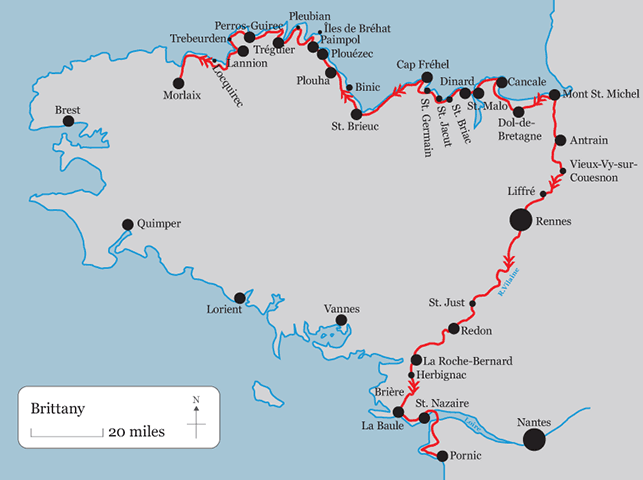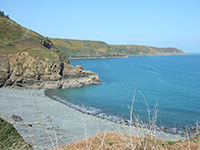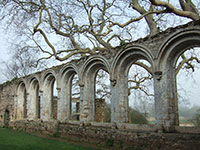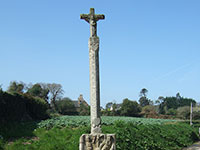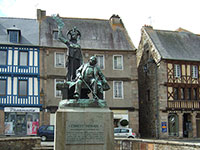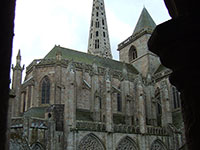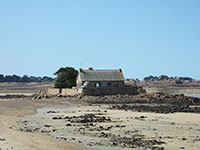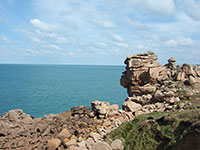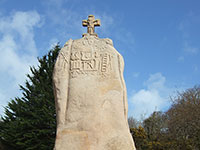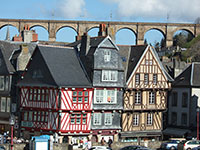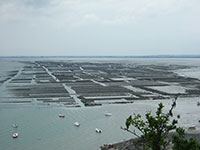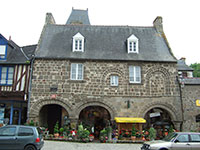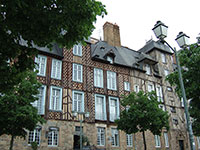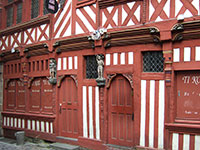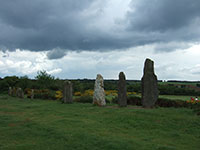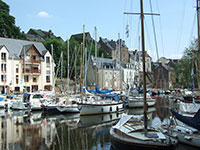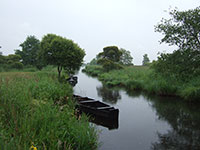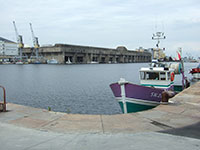Brittany
Photo: Terry west of Locquirec
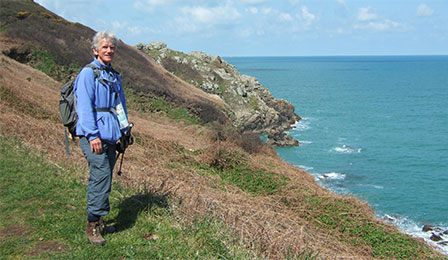
The region
Landscape
The north coast is the crumbling edge of a granite plateau. Sometimes the cliffs are high with dramatic views over the ocean. More often they are low, like the remains of a giant quarry.
Often the tide retreats beyond the horizon to create a new landscape for a few hours. Once it is out the sea bed looks like a giant slag heap of black rocks.
The pink granite outcrops on the way to Ploumanac'h have been eroded into separate boulders like the tors of Dartmoor.
The Sillon Talbert is similar to the Chesil Bank in Dorset, a three kilometre long barrow of pebbles, sand and coarse grass running out into the ocean.
The difference between high and low tide on the North Coast of Brittany is greater than average, particularly near St. Malo where the sea bounces off the Cotentin Peninsula opposite like water in a bath tub. There is a barrage across the Rance estuary nearby which uses this forty foot surge to generate electricity.
Walking along the coast is not a simple matter because there are so many tidal estuaries and headlands to circumnavigate.
There are some stretches of the north coast which are not granitic; e.g. the Bay of St. Michel where rich alluvial fields stretch as far as the eye can see; the marsh behind an old sand bar east of Trebeurden; the Bay of Saint Brieuc, an infinite space of mud flats and sky; the sandy bays between Cancale and St. Malo full of dunes and fragile flora; the narrow sand bar which joins St. Malo to the mainland.
Eastern Central Brittany looks like the Devon countryside; old tracks between the hedgerows looking out across fields and oak woods. This is the bocage so characteristic of so much of Brittany.
A typical stretch of old Breton heath can be found around the menhirs of St. Just. It is like an outside sculpture park, the naturally eroded granite of the stones contrasting with the yellow of gorse and broom, and the varied greens of grass and pine.
Approaching the south coast near La Baule the soil became sandier and the trees were mostly pine.
The vast peat bog of La Grande Briere is one of a number of wet zones stretching from the Golfe du Morbihan to the mouth of the Loire. A thick carpet of reeds, coarse grasses, yellow irises and other plants thrive in the saturated jet black soil. There is very little colour except for a rich green. A series of long canals divide the marsh, constantly threatening to burst their banks.
Beyond Pornic the continuous coastal development dropped away to reveal a wide expanse of marais salants, a marsh-like expanse of ponds divided by small meadows.
Buildings
The granite which is the peninsula's bed rock lends an austere character to many of its buildings.
In Dol-de-Bretagne the granite medieval buildings along the main street have stumpy pillars supporting rustic arches under upper storeys of wood and plaster. This rugged solidity is echoed in the cathedral.
In Treguier the ecclesiastical granite sits heavily on the ground, grey and forbidding. The central tower of the cathedral is squat, pinning the great church down to earth. The narrow streets contain buildings made of wood and granite - an imposing Episcopal palace now the mairie, the old bishop's quarters with a round tower, the medieval house of Duke John V, the Augustinians' house and the massive seminary now a lycee.
The decorations on country churches have a naive simplitity, charming and unsophisticated; i.e. an ancient worthy on top of a turret at Locquirec, a tower topped with balustrades like a tiered wedding cake at Saint Briac, a pink granite spire with finials around the brim like peppermills at Perros-Guirec.
Many of the domestic buildings of northern Brittany are also built of grey granite, from small cottages with dormer windows to gaunt manoirs with defensive towers.
Near the Vilaine in southern Brittany the walls of simple cottages consisted of small tightly packed pieces of schist put together with precision and care. South of Redon were the first of many thatched cottages in the Loire-Atlantique, also built of schist. More thatched cottages appeared on the edge of the Briere national park.
In Lannion I came across the widespread use of wood in older houses. In the main square, the crazy composition of gables, dormer windows and carved beams looks like something straight out of Balzac. Similar houses give the squares in Morlaix an immediate appeal. There are many magnificent wooden houses of the fifteenth and sixteenth centuries in the centre of Rennes which testify to merchant wealth. Ti Koz with its patterned beams and exuberant carvings is a good example.
Faith
Brittany has always had a strong Catholic tradition mixed up with popular faith in saints and sacred places, like Saint Yves at Treguier, a thirteenth century lawyer who dispensed justice fairly to all and performed miracles.
Belief spills out over the landscape. North of Paimpol the countryside described by Pierre loti in Les Pecheurs d'Islande is still rich in Christian symbols e.g. on the way to Ploubazlanec a very unusual cross on a three sided base to represent the Trinity. Wayside crosses are of course common all over France but particularly in Brittany.
There are many chapels and grottos to thank the Virgin Mary for a particular act of grace.
Saint Brieuc is named after one of the seven founding saints of Brittany, who like several of his colleagues came over from Wales to evangelise the peninsula in the fifth and sixth centuries.
Yaudet near Lannion is a religious site in which one set of religious beliefs has been built on earlier ones. Ancient earth ramparts overlook the mouth of the River Leguer. The headland was occupied by Neolithic peoples and then by the Celts whose Druids also waited for a Virgin to give birth. The Romans built a temple here and to win favour with the locals they included a statue of Cybele, the Goddess of the Earth and Mother of the Gods. They represented her in bed suckling a small child. When the Christian peoples arrived from Britain they adopted this idea when worshipping the Virgin. The old church contains a charming if sentimental representation of the Virgin Mary behind the altar. She lies in a bed complete with a lace coverlet and all the bed clothes of a nineteenth century lady. The site would not be complete without a holy fountain dating from the Middle Ages.
There is plenty of evidence of the purely pagan past. One of the earliest sites is the Menhir du Champ Dolent just outside Dol-de-Bretagne. This is a large standing stone about ten metres high in a field close to the suburbs of Dol.
Some of the menhirs of St. Just mark spots where men and women lived, others the boundaries of assembly for men and beasts, others may have had a sacred purpose, or served as tombs for the remains of ancestors.
The Menhir of St. Uzec is a tall Neolithic standing stone situated on moorland near Trebeurden. The instruments of Christ's Passion have been carved on the front and a stone cross placed on top. It was probably built over 4000 years before Christ but only Christianized during a mission in the seventeenth century.
Catholicism underwent a major revival after 1800 and has proved a potent force in Brittany throughout its modern history. Some extraordinary events took place in Treguier in 1903. The great scholar Ernest Renan was born and brought up here in the Catholic faith. Later he subjected the Bible to critical examination. While he could see the social use of religion he abandonned many of the church's doctrines. To believers in his native town he was a traitor. The leader of the French government came to unveil a statue of Renan in the square outside the cathedral, eleven years after the writer's death. There was a violent protest by Catholic traditionalists who went on to erect a large calvaire elsewhere in the town. By doing this they hoped to expiate the sins of those who had supported Renan.
Breton language
There was a time when the majority of Bretons, certainly west of Saint Brieuc, spoke Breton.
Since the advent of mass education in French and the modernisation of the economy most young Bretons have stopped using the language. State support for Breton is more limited than for Welsh. It is only taught in schools if the parents specifically request it. Several retired people told me how their teachers had discouraged them from speaking Breton at school. Now however there is a modest revival of interest in the language.
History
Brittany was a separate state until its merger with France in 1532. The first Duke of Brittany founded an abbey at Redon in the ninth century and had pushed the Vikings out of the land south of Pornic by 937.
Prosperity grew steadily after the union with France, witness the grand houses and public buildings in the centre of Rennes.
The Revolution marked a turning point as the province was torn apart in a civil war between supporters of the Republic, the Blues, and the followers of the monarchy and the Catholic church, the Whites or Chouans. I found evidence of this at Antrain, north of Rennes, and at La Roche-Bernard on the Vilaine.
In the nineteenth century Brittany took something of a step back into the past. While the rest of France was industrializing, Brittany's traditional industries, such as textiles, declined and shed labour. Many Bretons left the countryside and some quarters of Paris became Breton towns. Nostalgia allied to sympathy for the sufferings of the Breton people developed in the arts. Loti's Pecheurs d'Islande is a good example. Moreover Bretons were made to feel inferior if they only spoke their native language. This feeling of backwardness and decline continued in the inter-war years and the peninsula rallied massively to Petain in 1940.
I saw plenty of reminders of the Second World War - the destruction by bombing of St. Malo, the German submarine base at St. Nazaire, the fortifications of the Saint Nazaire pocket, the sites of Resistance operations on the north coast.
Economics
Since 1945 Brittany's fortunes have been transformed by a period of unparalleled economic development starting with agriculture. Now Brittany is one of the agricultural power houses of France. The Bretons not ony raise cattle, pigs and sheep but grow everything from cereals to artichokes and cauliflowers.
Brittany also has a long tradition of sea faring. Deep sea fishing is now a shadow of its former self but the cultivation of shell fish still prospers inshore.
After the disappearance of the Icelandic cod fishing fleet based around Paimpol many turned to the merchant marine, but this in turn has suffered from third world competition.
Shipbuilding is still active at St. Nazaire.
Brittany has a holiday coast afflicted by ribbon development - hotels, camp sites, bungalows, mobile homes, flats, cafes, car parks, golf courses, casinos, marinas - a real coastal suburbia.
Some resorts like Perros-Guirec, Locquirec and La Baule have clearly been built for a more prosperous clientele.
There are many second homes in the coastal settlements and most of the owners are outsiders. Many are retired. The development of tourism has destroyed the sense of community. The inhabitants often have to travel long distances to find work.
While tourism has emptied some of the north coast communities of life, the picture is different near Rennes, one of the fastest growing grandes villes in France.
Back to top
Diary extracts
Maintaining Breton culture
Remi Le Marrec was keen to stress his Breton origins, telling me that his name meant knight in Breton. His cottage was in a quiet hamlet near Herbignac in the Loire-Atlantique. Geese and goslings were pecking the grass much to the delight of the small girl in the house and the atmosphere suggested a couple who preferred an unconventional lifestyle. Remi had long blond hair and blue eyes and I was not surprised to discover that his mother was Dutch. His wife was totally French and they had moved from Paris. "I used to work in the merchant marine," he said, "but had to leave because the prospects were so poor. I plan to re-train as a naval shipwright. I want to build traditional Breton boats out of wood." Although he lived in the Loire Atlantique department, he regarded himself as a proper Breton. "A lot of Breton music is still played," he said, "and there are Breton dances too." His son treated us to a dance tune on his miniature accordion. The small boy took it very seriously and his tune was haunting. Remi played a traditional Breton instrument called the bombarde, rather like a recorder. He was critical of France's monolingual policy. "Breton is the only proper language in France apart from French itself," said Remi, "and now only about 10% of the population of Brittany speak it, mainly west of a line from Saint Brieuc to Vannes. Gallo used to be spoken east of this line but it is a French patois. Breton is only taught in a few schools and has no special status in the world outside." I asked why more people did not speak the language. "People think of it as backward, provincial and old fashioned, particularly the young. It just isn't cool!" was the reply.
A Gallic brush off
One day I was walking through the Foret de Rennes to my hotel at Liffre. As thunder rumbled overhead I stepped up my pace. Reaching the bridge over the main road just as the heavens opened, I sprinted for the front door, arriving in a smart reception area looking thoroughly dishevelled.
The hotel was a modern purpose built Logis de France. It looked comfortable enough but when I enquired about the possibility of a packed lunch for the next day, the conversation went something like this: -
"Can you provide me with a picnic lunch for tomorrow?"
"No, I am afraid not; we don't do that sort of thing!"
"Really. You could not find a scrap of bread and cheese and maybe a piece of fruit."
"Well no, because that would mean we would have to have ordered the bread (half a baguette) and the apple in advance! It would really be more convenient if you went to the local shops to get what you want."
"You mean you have absolutely nothing left over after breakfast."
"No, we know exactly how much bread we will need in the morning and there will be nothing left over."
"You obviously don't understand that I am walking long distances each day and I don't really want to walk four miles in the wrong direction when as a large hotel you ought to be able to provide a casse-croute (French for something to keep you going)."
"I cannot help that. Picnics are not something we normally provide."
"So you are not prepared to help me out."
"Well I suppose I could go and ask the chef."
"Please do that."
"What time do you want this picnic?"
"9.30am when I leave."
"Oh well in that case we can probably provide something but it won't be very special."
"I don't need anything special; just something to keep me alive!"
Back to top
The Walk
View more details.
From Mont St. Michel I walked south down the Couesnon river and then cut across the polders to Roz-sur-Couesnon. From here I followed the line of the GR34, with some local variations, to Dol-de-Bretagne, Cancale and St. Malo. From St. Malo I continued along the coast, following the GR34 through Dinard, St. Briac, St. Jacut, St. Cast, Cap Frehel, Erquy and Val-Andre to Saint-Brieuc, again with some local variations.
From Saint-Brieuc I continued on the GR34 all the way to Morlaix passing through Paimpol, Treguier, Perros-Guirec, Lannion and Locquirec.
From Mont St. Michel I also walked south along the Couesnon to Pontorson, and then on the line of the GR39 with local variations through Antrain, Vieux-Vy-Couesnon and Liffre to Rennes. From the Breton capital I continued on the GR39 through Bourg-des-Comptes, Messac, St. Just, Trobert and Sainte Marie to Redon. South of Redon I continued on the GR39 with some variations where it became indistinct, but turned off to cross the R. Vilaine at the Pont de Cran and walk along local footpaths through Couedic and Nivillac to La Roche St. Bernard. From here I cut across country on local footpaths, through Herbignac and the Parc Regional de Briere, to La Baule and Saint Nazaire. Having crossed the Loire, I continued on the GR8 along the coast all the way to Pornic and into the Vendee.
The total distance from Mont St. Michel to Morlaix and from Mont St. Michel to Pornic is 559 miles.
Back to top
Maps and Guides
Mont St. Michel to St. Brieuc: IGN 1;25.000 maps 1215OT, 1116ET, 1016ET, 0916ET
St. Brieuc to Morlaix: Topoguide Cote de Granit Rose GR34 Ref. 346.FFRP.
Mont St. Michel to Pornic: IGN 1:25.000 maps 1215OT, 1216E, 1217E, 1218E, 1218O, 1219O, 1220O, 1120E, 1120O, 1121O, 1021E, 1022OT, 1023OT, 1123OT
Back to top
Weather
I encountered no particular weather problems walking around Brittany. Obviously a walker on the coast can be exposed to gales and heavy rain from time to time.
Back to top
Accommodation
I had no difficulty finding accommodation. I list below places where I stayed which I can particularly recommend. I have not covered every stopping place on my route. There are fewer gite d'etapes on the west coast of France. Some of the hotels are old fashioned.
West from Mont St. Michel
Hotel Le Nautilus
9 rue de la Corne de Cerf
35400 St. Malo
Tel. 00 33 (0)2 99 40 42 27
Fax 00 33 (0)2 99 56 75 43
Chambres d'hotes La Maison Bleue Jaguine
Mme. Maryannick Mouton
10 bis rue du Chatelet
22750 St. Jacut
Tel. 00 33 (0)2 96 27 77 12 or
06 62 76 62 73
Fax 00 33 (0)2 90 35 13 00
http://www.lamaisonbleuejaguine.com
Hotel des Bains
rue du Calvaire
22240 Pleherel Plage
Tel. 00 33 (0)2 96 41 41 01
Fax 00 33 (0)2 96 41 32 39
contact@hotel-restaurant-frehel.com
http://www.hotel-restaurant-frehel.com
Chambres d'hotes La Villa Marguerite
Mme. Levive Campion
34 rue des Garennes
22370 Pleneuf Val Andre
Tel. 00 33 (0)2 96 72 85 88 or
06 08 04 08 07
http://www.villa-marguerite.fr
Chambres d'hotes Yves et Francoise Disquay
5 bis rue de Kerivois
22580 Plouha.
Tel/Fax 00 33 (0)2 96 22 41 08 or
06 82 72 45 87
http://www.gites-de-france.com/gites/fr/chambres_d_hotes
Chambres d'hotes Josette et Raymond Charles
1 chemin Vert
rue Guillaume Le Quere
22470 Plouezec
Tel. 00 33 (0)2 96 22 71 07 or
06 12 01 08 70
http://www.gites-de-france.com/gites/fr/chambres_d_hotes
Hotel Le Barbu
Pointe de l'Arcouest
22620 Ploubazlanec
Tel. 00 33 (0)2 96 55 86 98
Fax 00 33 (0)2 96 55 73 87
Chambres d'hotes Toshihiko et Edith Wake
6 route des Perdrix
Lan Caradec
22740 Lezardrieux
Tel. 00 33 (0)2 96 20 10 25 or
06 61 58 96 79
http://www.gites-de-france.com/gites/fr/chambres_d_hotes
Hotel de la Presqu'Ile
Mme. Rose-Marie Alanic
27 rue Pleumeur
22610 Pleubian
Tel. 00 33 (0)2 96 22 91 19 or 06 82 35 16 00
Le Grand Hotel du Port Blanc
22710 Penvenan
Tel. 00 33 (0)2 96 92 66 52
Fax 00 33 (0)2 96 92 81 57
http://www.hotel-port-blanc.com
Hotel du Parc
174, rue Saint-Guirec
22700 Ploumanac'h
Tel. 00 33 (0)2 96 91 40 80
Fax 00 33 (0)2 96 91 60 48
hotel.du.parclacotriade@orange.fr
Chambres d'hotes Isabelle Robert
Traou ArVilin
route de Crec'h Lagardurien
22560 Pleumeur Bodou
Tel. 00 33 (0)2 96 23 37 96 or
06 70 50 92 91
Chambres d'hotes Evel Er Ger
1a rue du Varcq
29241 Locquirec
Tel. 00 33 (0)2 98 79 35 79
Fax 00 33 (0)2 98 67 49 63
Gite d'etape Maison de Kerdies
Mireille Le Moigne
5 route de Perherel
Saint Samson
29630 Plougasnou
Tel. 00 33 (0)2 98 72 40 66
South from Mont St. Michel
Hotel de Bretagne
17 place Chateaubriand
35120 Dol-de-Bretagne
Tel. 00 33 (0)2 99 48 02 03
Fax 00 33 (0)2 99 48 25 75
Chambre d'hotes Eugene et Simone Menard
5 rue de la Tannerie
35490 Vieux-Vy-sur-Couesnon
Tel/Fax 00 33 (0)2 99 39 53 08 or
06 82 10 35 93
chambredhotescouesnon@orange.fr
http://www.gites-de-france.com/gites/fr/chambres_d_hotes
Chambres d'hotes Yvette Guillope
Epineu
35890 Bourg-des-Comptes
Tel. 00 33 (0)2 99 52 16 84 or
06 25 60 23 22
http://www.gites-de-france.com/gites/fr/chambres_d_hotes
Chambres d'hotes La Maison Jaune
Patrice et Sylvie Hulbert
31 rue de Vannes
35600 Redon
Tel/Fax 00 33 (0)2 99 72 22 30 or
06 66 50 95 81
http://lamaisonjaune.monsite.wanadoo.fr
Chambres d'hotes GAEC Le Moulin de Couedic
Marie-Pierre et Joseph Chesnin
Saint-Cry
56130 Nivillac
Tel/Fax 00 33 (0)2 99 90 62 47 or
06 76 57 68 44
Chambres d'hotes Ker Liberin
Remi et Magali Le Marrec
44410 Herbignac
Tel. 00 33 (0)2 40 91 42 66
Chambres d'hotes Piedade Leroy
82 avenue Guy de la Morandais
44500 La Baule
Tel/Fax 00 33 02 40 60 87 10 or
06 63 06 09 18
Hotel l'Empreinte
119 bd. de l'Ocean
44730 Tharon Plage
Tel. 00 33 (0)2 40 27 82 17
Fax 00 33 (0)2 40 39 94 03
http://www.hotel-restaurant-lempreinte.com
Hotel Beau Soleil
place du Petit Nice
44210 Pornic
Tel. 00 33 (0)2 40 82 34 58
fax 00 33 (0)2 40 82 43 00
http://www.annedebretagne.com/beausoleil
Back to top
Photographs
Click on the thumbnails below to see larger images with captions.

